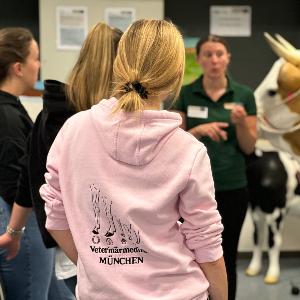Veterinary medicine: The bridge between theory and practice
16 Jul 2024
In the VetSkillsLab at LMU Munich, veterinary students can hone their skills – sometimes with the help of a modified stuffed animal as a training partner.
16 Jul 2024
In the VetSkillsLab at LMU Munich, veterinary students can hone their skills – sometimes with the help of a modified stuffed animal as a training partner.

Veterinarian Dr. Sonnewald-Daum and her students in the compact course on ruminants. | © LMU
"Can you put the stethoscope where are you can listen to it?" veterinarian Dr. Sonnewald-Daum asks her course participant Esther Zimmermann. The veterinary student skillfully places the stethoscope on the left lateral abdominal wall of the model cow "Bella" and imitates listening to the rumen motor function.
Sonnewald-Daum observes the process and scrutinizes Esther's work steps. In the compact course on ruminants, typical cases of disease are practiced on the animal. And all without a cowshed or live patients.
Just a few meters from the English Garden is the VetSkillsLab - a practical training center for all veterinary students and trainees in animal care at LMU. Here, the theoretical knowledge acquired during their studies and training can be put into practice, improved and repeated on more than 100 simulation models.
It's certainly something else to actually work on animals. But I think it's a good way to bridge the gap between theory and practice.Malin Hanselmann, Veterinary student
The range is extensive - in addition to typical domestic and farm animal models of dogs, cats, mice, pigs, cattle and horses, there are also more exotic models such as snakes and turtles. This means that almost every frequently used technique, such as inserting a venous catheter or artificial insemination, can be practiced.
The VetSkillsLab focuses on learning and training so-called "Day One Competences". In other words, the main focus is on practicing the skills that veterinary students should be able to master on their first day in the profession after completing their studies. The students are happy about the VetSkillsLab, "because you can try out lots of things and not break anything," says student Esther Zimmermann.
Dr. Bukenberger, one of the directors and co-founders of the VetSkillsLab, recalls: "When I was a student, there was no such facility and we didn't have these training opportunities. You learned the theory and at some point you met an animal." The VetSkillsLab now closes this gap.
Students can carry out a wide range of practices on the model and practice them several times - "on a model that doesn't fidget, in peace and quiet, without all the stress factors that come with real life," as Bukenberger explains."It's certainly something else to actually work on the animal," says veterinary student Malin Hanselmann. "But I think it's a good way to bridge the gap between theory and practice."
The performance of certain exercises, such as the insertion of venous catheters or rectalization, on live "practice animals" by numerous students is not justifiable for animal welfare reasons. The extensive practice opportunities on models and simulators in the VetSkillsLab give all students the opportunity to hone their practical skills without endangering animal welfare.
"You can't study veterinary medicine without learning on live patients. We can't completely replace working on live animals, that would be an unrealistic goal, but we can serve the 3Rs principle by reducing the number of animal experiments required," explains Bukenberger.
In line with the 3Rs principle of animal welfare, the VetSkillsLab cannot completely replace animal experiments in veterinary training (R = replace), but it can reduce them to a minimum (R = reduce). In addition, the stress on the animals to be treated can be kept to an essential minimum (R = refine), as students become more confident and experienced in carrying out the practices by practicing on the model. The students benefit from the fact that they act more confidently after practicing on the models. The first treatment in practice is nevertheless challenging, but the pressure for the students is significantly reduced and therefore also the stress for the animal being treated.
We can't completely replace working on live animals, that would be an unrealistic goal, but we can serve the 3R principle by reducing the number of animal experiments required.Dr. Bukenberger, Head of the VetSkillsLab

Tutor Jannes Petereit on the horse model | © LMU
The courses on offer range from two-hour compact courses to electives lasting several weeks. "In the electives in particular, we also try to cover topics that are otherwise neglected in the course, such as communication with patient owners," says Head Bukenberger. "Some content can be learned through self-study. However, there are always tutors or veterinarians on hand to support the course."
The range of simulation models available on the commercial market is far from sufficient to meet the demand for training in veterinary skills. "That's why a few years ago we started modifying models in our workshop or even developing them ourselves," explains Head Bukenberger.
Depending on the requirements of the exercises, the techniques are carried out on converted stuffed animals and decorative figures as well as on commercial models. In order to keep up with the current state of research, the offer is constantly being further developed in close contact with the various veterinary clinics of the faculty. Since the VetSkillsLab opened in 2018, the team of 17 has continued to grow steadily. Bukenberger reports enthusiastically: "We recently hired a sculptor to help us develop the models."
The VetSkillsLab consistently receives very good feedback from students in evaluations. "This is of course always a great motivation for us! In addition, the close cooperation with the clinics is beneficial for everyone because the students in the VetSkillsLab are prepared for practical work in the clinics," says the director with satisfaction.